
Sounds from Fayazullah’s Unfound Village
Fayazullah (stoker) from Damrasari, Hirpur Bazar, Sylhet became a story about a lost place and a found song. Looking for Damrasari, I went from place to place, met a curious bunch of people, almost reached the Indian border at Tamabil and recorded song and dance I wasn’t at all expecting to find.
Out of the 15 cylinders on which Arnold Bake recorded the sailors on board the Streefkerk between 1 and 15 April 1934, five (nos. 343, 347, 348, 349 and 350) were of Fayazullah. Out of these five songs I was drawn to two in particular–cylinder no. 343 entitled ‘Shey dukh’ and cylinder 348, ‘O pran nath’. Something seemed very familiar to me, something I could hear under the noise of those cylinders, in the skidding, and in the undecipherable words of the songs. And then as I kept listening, I knew what the reason for this attraction was. The style of singing was so much like that of Ranen Roychowdhury of Ritwik Ghatak’s films.
This then was perhaps what Ranen Roychowdhury used to hear? This was perhaps the kind of person whose company he used to keep in the shrine of Shah Jalal, and from whom he learned many songs?
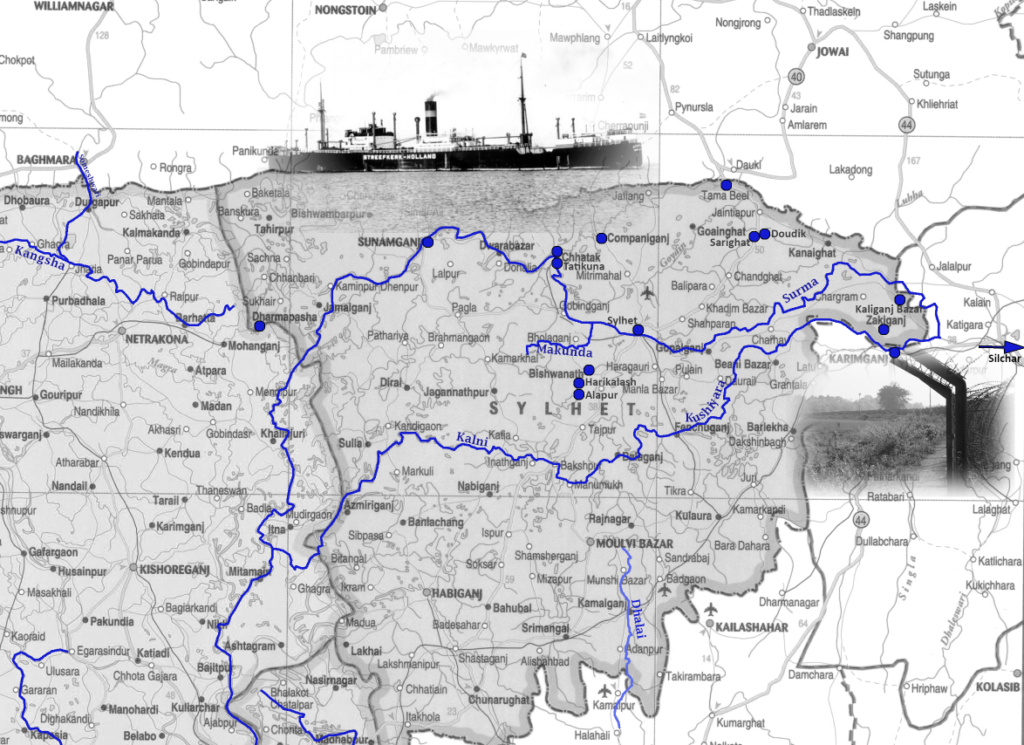
Some said, maybe Fayazullah was from Dharmapasha. But why would Bake write Damrasari for Dharmapasha? So, we went in the opposite direction, following clues from the place-names in the archival note. Map by Purba Rudra.
On 15 January 2018, I went with my long-time friend and guide in Sylhet, Ambarish Datta, to meet the 90-year-old Sushoma Das, whom we first met in 2006 and have been recording since. Sushoma ‘Mashima’ as we call her, mashima meaning aunt, holds a very special place in the life of The Travelling Archive and I personally see her as a repository of the deepest and most profound knowledge of the music of her region; a living archive of songs. We will talk about this particular meeting with Sushoma Mashima in another sub-chapter , but what we are talking about here is the journey Ambarishda and I made three days later, on 18 January 2018 in search of Fayazullah’s village.
Damrasari did not immediately suggest any place to my friends, but since Sari is the name of a river and there is a place by the name of Sarighat on the way from Sylhet town to the Tamabil border with India and since there is a Haripur on the way, which is soundwise close enough to Hirpur, we decided to go and look around there.
Ambarishda used to work as a banker when I first met him in 2006, all ‘suited and booted’ as we say in Bangla. But, since he left his job, he has let go of his attire and many old habits and has taken to growing things in a small plot of land, while cultivating the poetry and song which is part of his inheritance and rests in his soul (he used to be into theatre in his youth and his father, as we know, was a kirtan singer. On our way to Haripur, we stopped in his garden in Noagaon, which is near the dargah of Shah Poran.
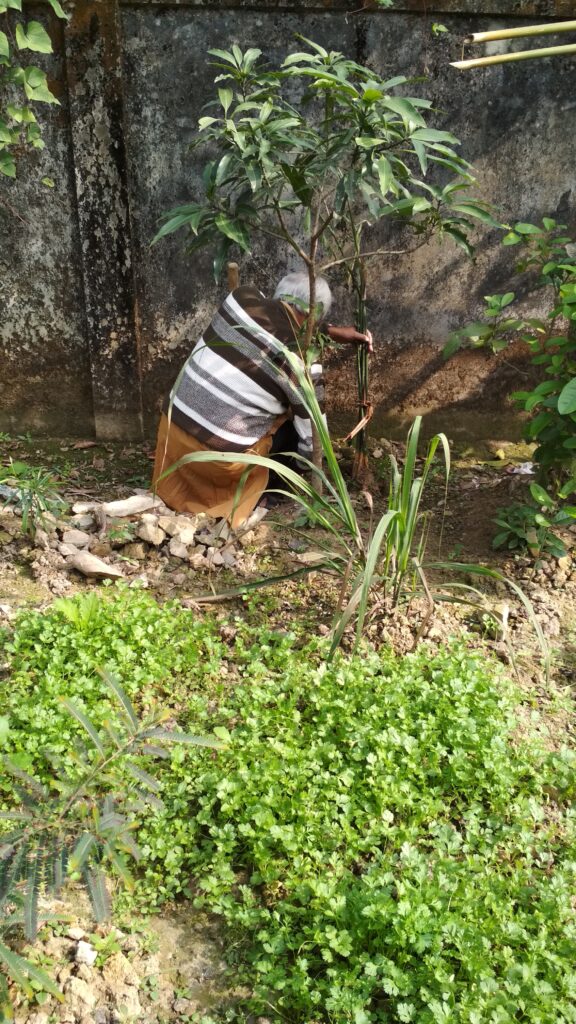
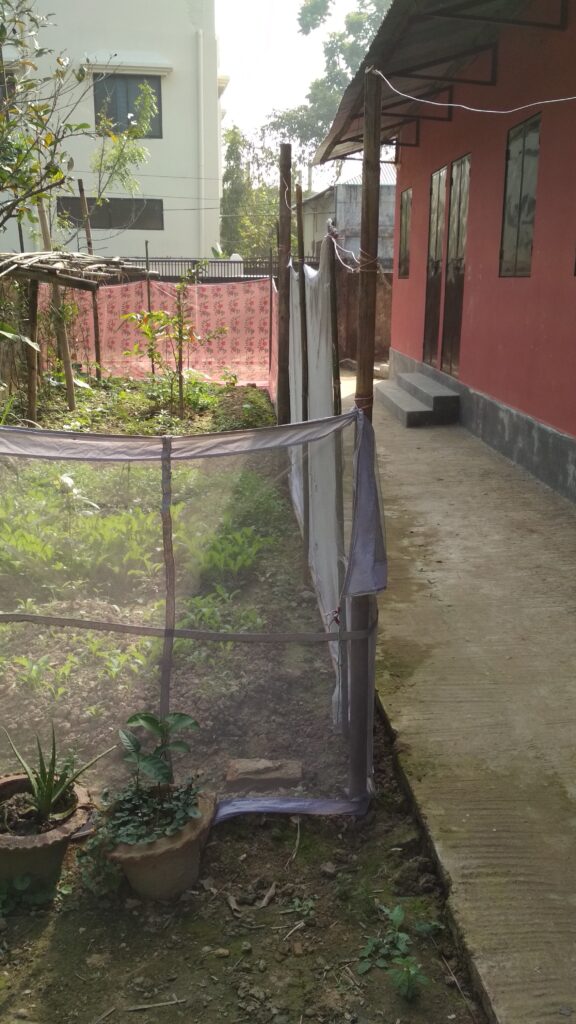
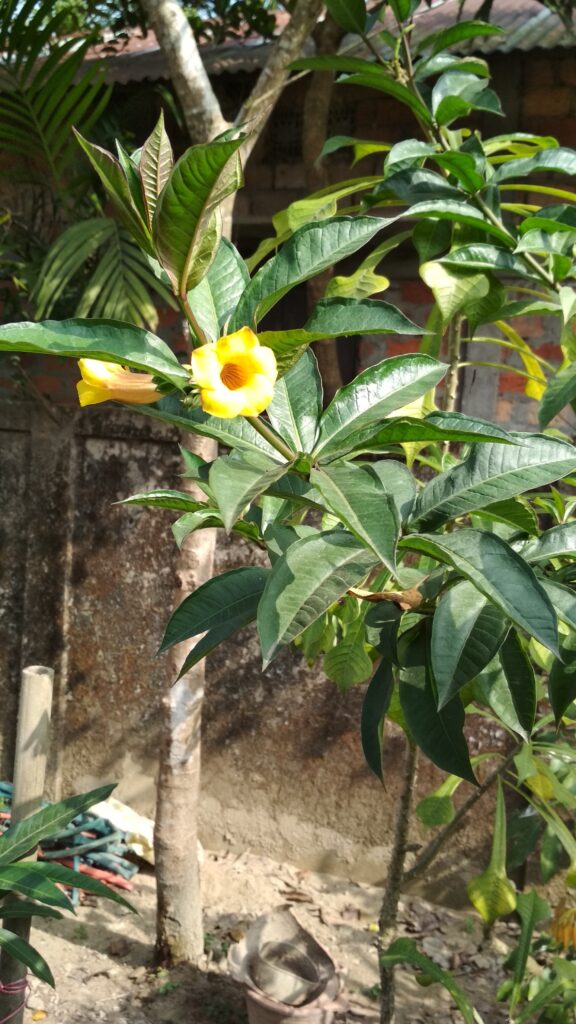
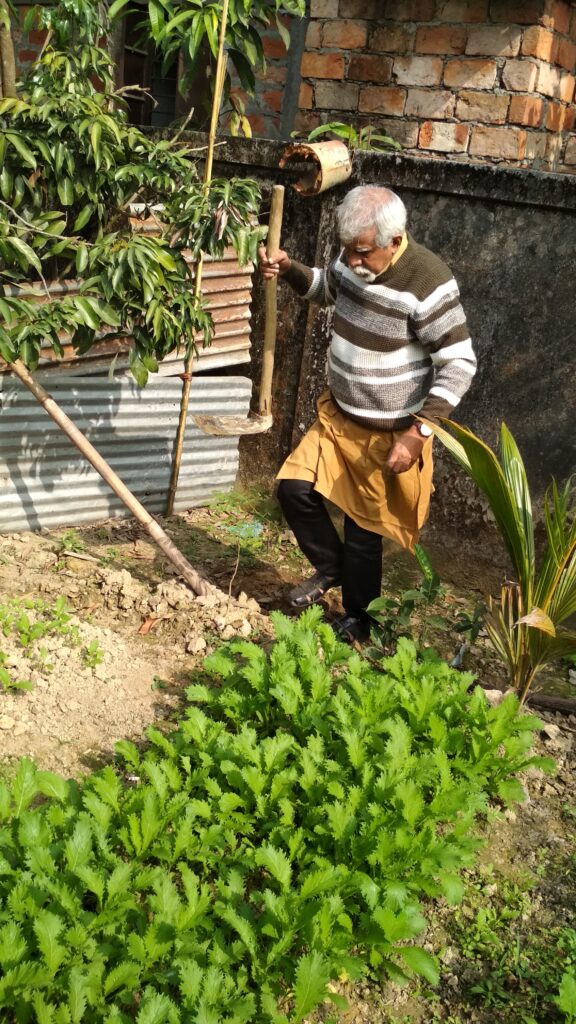
Ambarishda’s garden, 18 January 2018. Photo: Moushumi
In Haripur Bazar, we stopped to ask people about Damrasari but no one could say anything. A man by the name of Azad Miah got interested in our story and got into our three-wheeler and joined our search. From this point it is Azad bhai who took the initiative to explain to people the story of Fayazullah’s song.
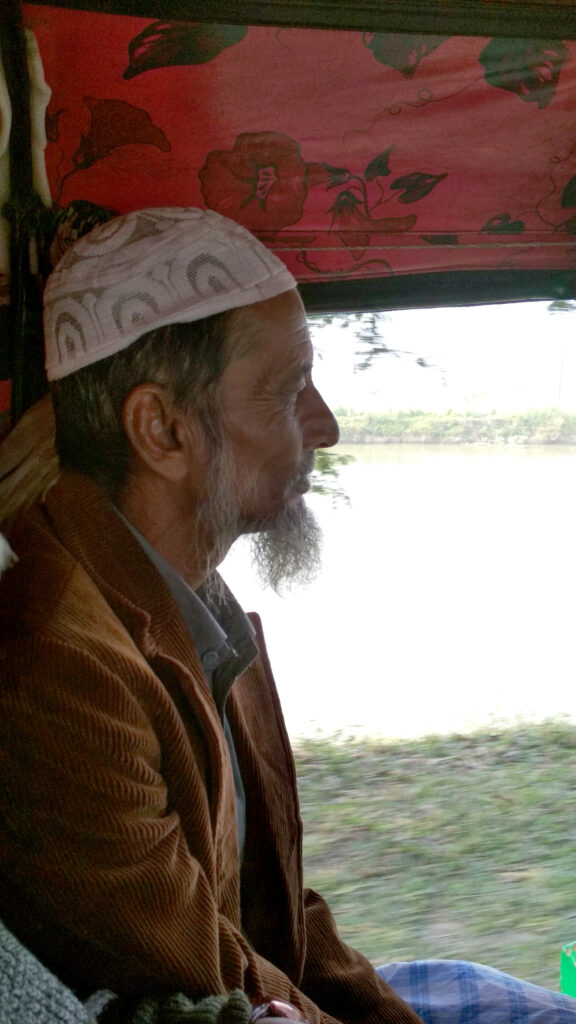
Azad Miah joins the search party. Photo: Moushumi
We stopped at Sarighat and went to a tea shop by the river and while Ambarishda and Azad Miah did the talking, I took some photos.
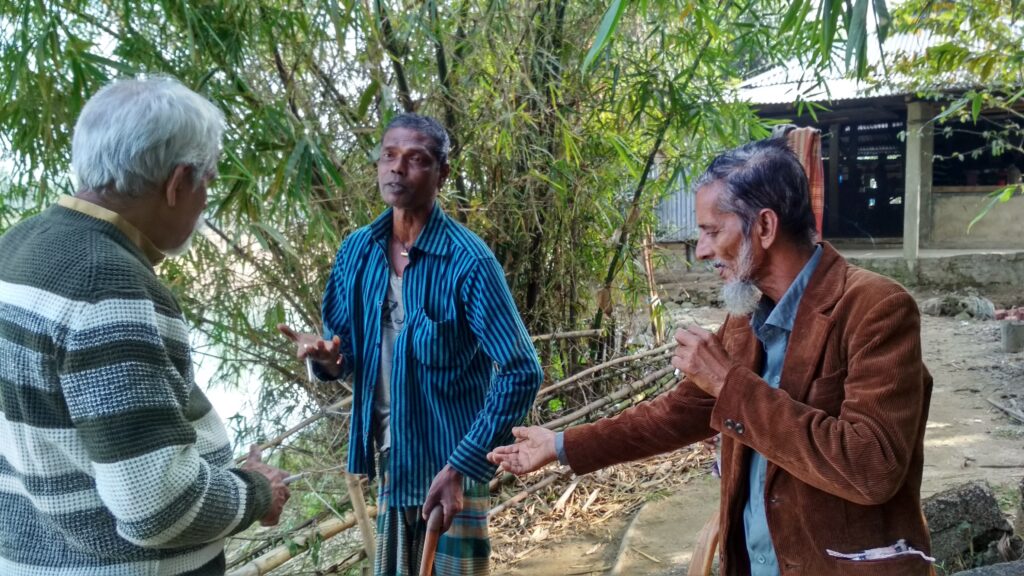
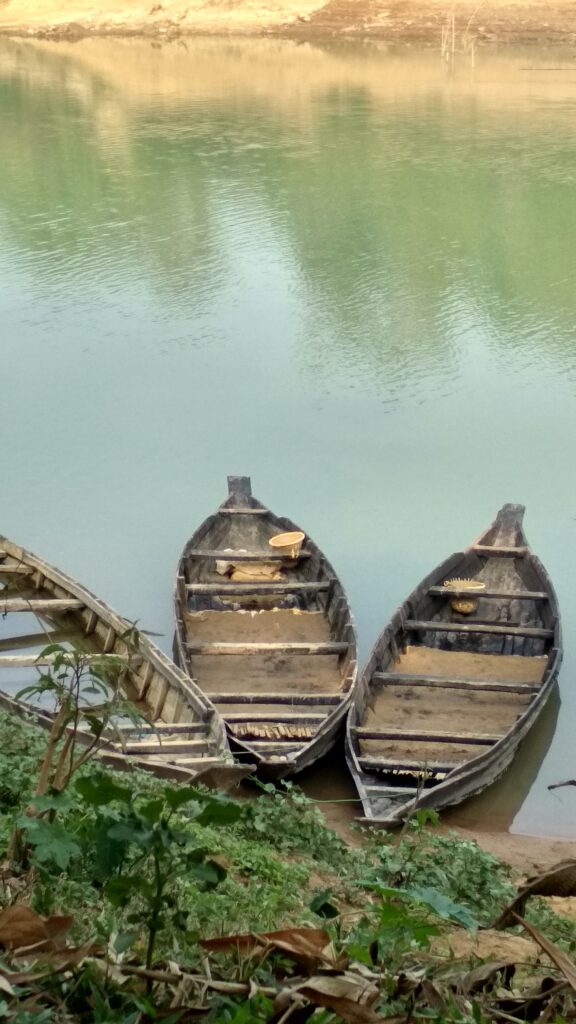
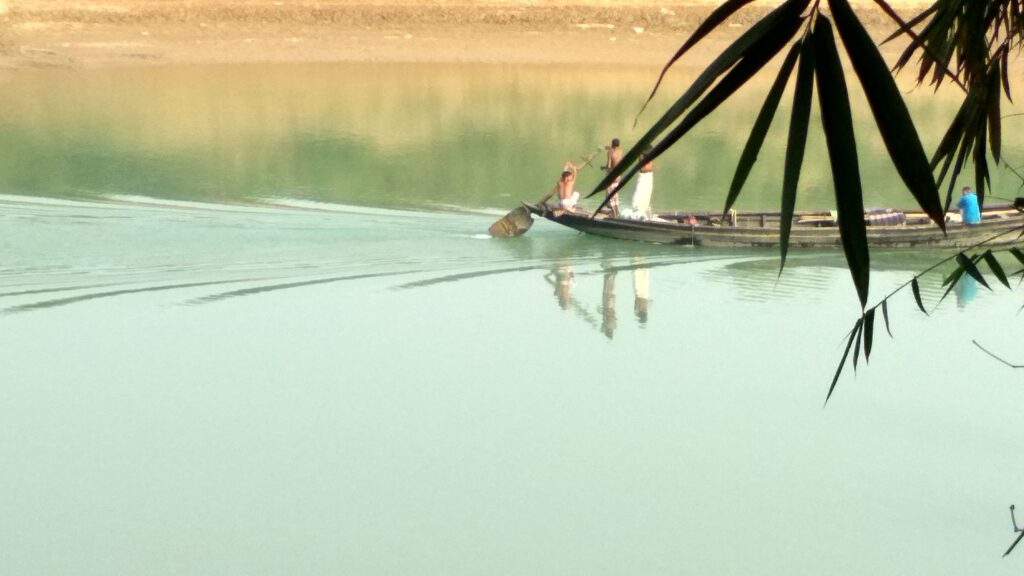
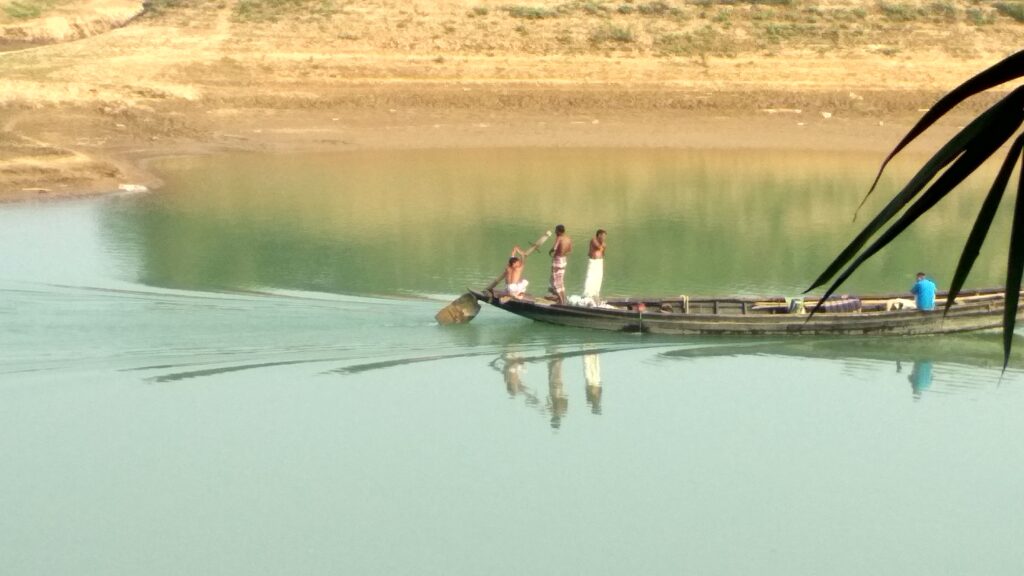
People said, if we went further down the road, we were likely to find houses of old jahajis or seamen. Not much of a lead, but we carried on going. Then we reached where there were ruins of the old Jaintia kingdom in the middle of the road; here the road turned right towards Doudik village.
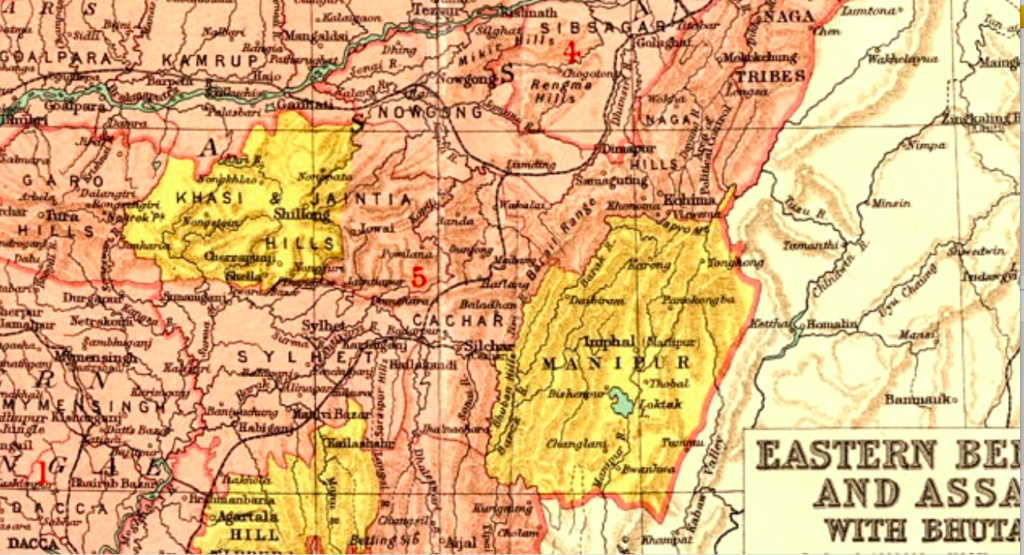
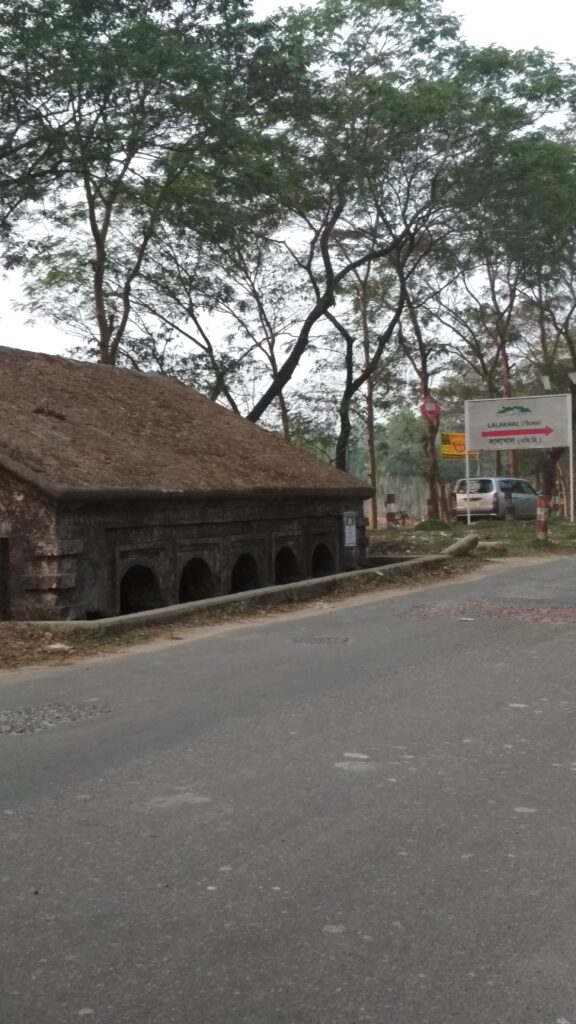
Left: Section of map of the Khasi and Jaintia Hills from the Bengal Gazetteer, 1907. Source: Internet. Right: Jaintia monument, said to be the Inn of Princess Irawati. Photo: Moushumi, 2018.
There was a grocery there, where we asked the shop-owner the same question that we had been asking everyone else: Do you know of a place called Damrasari? Do you know where old families of seamen from about a hundred years might live? Was there a Hirpur around here? The man at the shop had no clue.
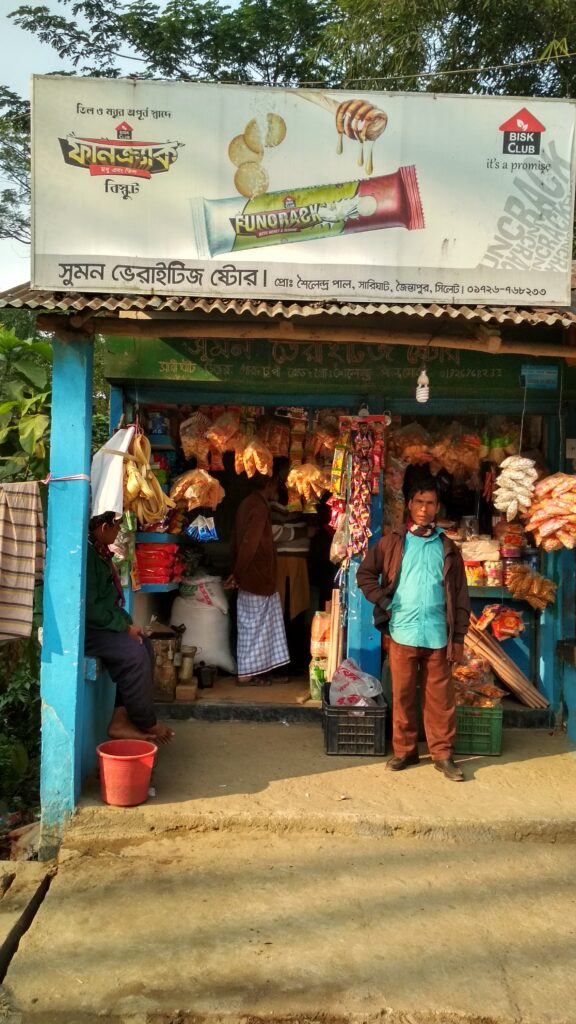
Suman Variety Store, Sarighat, Jaintapur, Sylhet. Proprietor: Shailendra Pal. Photo: Moushumi, 2018.
As I was trying to revise my memory of that afternoon, I sent some photos to Ambarishda and asked for details. He wrote back to say, আমরা যেখানে দাঁড়িয়েছিলাম এর ডান দিকে বাম দিকে উভয়দিকেই ডৌডিক। Doudik was on both sides of where we were standing, left and right. We were following Azad Miah’s directions and looking for Dharma village. The river was the Sari-Goain, but usually called the Sari. The monument in the middle of the road used to be a gate of the Jaintia kingdom and an inn. A few kilometres from there was the capital of the Jaintia kingdom. The Tamabil border would be 15 or 20 km down the road. There was an earthquake in 1897 which destroyed the old Rameswar temple of the kingdom, but a few years ago there were heavy rains and some old archaeological remains surfaced, which are now in the care of the government. We bought satkora lemons from Haripur Bazar. আমরা আসলে ধর্ম গ্রাম খুঁজছিলাম। আজাদ মিয়ার কথায় ঐদিকে কোনো সন্ধান পাওয়া যায় কিনা তাই গিয়েছিলাম। নদীর নাম সারি-গোয়াইন নদী। ঐ এলাকায় সারি নামেই অধিক পরিচিত। আমরা সারিঘাট গিয়েছিলাম। রাস্তার উপরে যে ঘর ওটা ঘর নয়, জৈন্তা নগর তোরণ। কয়েক কিলো সামনেই জৈন্তা নগর রাজ্যের রাজধানী। আর তামাবিল আরো পনেরো কুড়ি কিলো সামনে এগুলে। যে রাস্তা ধরে ডৌডিকে গেলাম চা নাস্তা খেয়ে মানে সুমন ভেরাইটি স্টোর যেখানে, ওখানে টিলার উপরর ছিল জৈন্তিয়া রাজার প্রতিষ্টিত রামেশ্বর শিব মন্দির। আর আরেকটু সামনে এগুলে অন্য টিলার উপরে ছিল ঢুপির মঠ। ১৮৯৭ সালের ভূমিকম্পে ধ্বংস হয়ে যায়। বছর কয়েক আগেও প্রবল বৃষ্টিপাতে মাটি ধসে পড়লে বেশ কিছু প্রত্ন নিদর্শন জলস্রোতে বেরিয়ে আসে। সরকারি হেফাজতে চলে গেছে। সাতকরা লেবু হরিপুর বাজার থেকে কিনেছিলাম। রাস্তার উপরে ওটা ছিল নগর তোরণ ও পান্থশালা। জৈন্তিয়া গেট নতুন নামকরণ। (From Whatsapp message sent to Moushumi on 26 January 2022)
So far finding Fayazullah or his village is concerned, there is not much more that happened that day. Yet there is a post-script to our story of sounds from Fayazullah’s unfound village. It goes thus. As we were standing in front of Suman variety stores, I saw a bunch of schoolgirls in full niqab walking in haste down the road, and two young men in a bicycle following, seemingly keeping a watch on them. They saw me watching the girls, taking a photo with my phone, and they did not seem to like it; at least that is how I felt. Azadbhai said these parts were becoming increasingly orthodox Wahabi. That got me thinking. I thought, even if Fayazullah went to sea from these parts, if we were to find him today, perhaps he would be under pressure not to sing his Sufi songs, such as we had seen with Ibrahim Boyati in 2013.
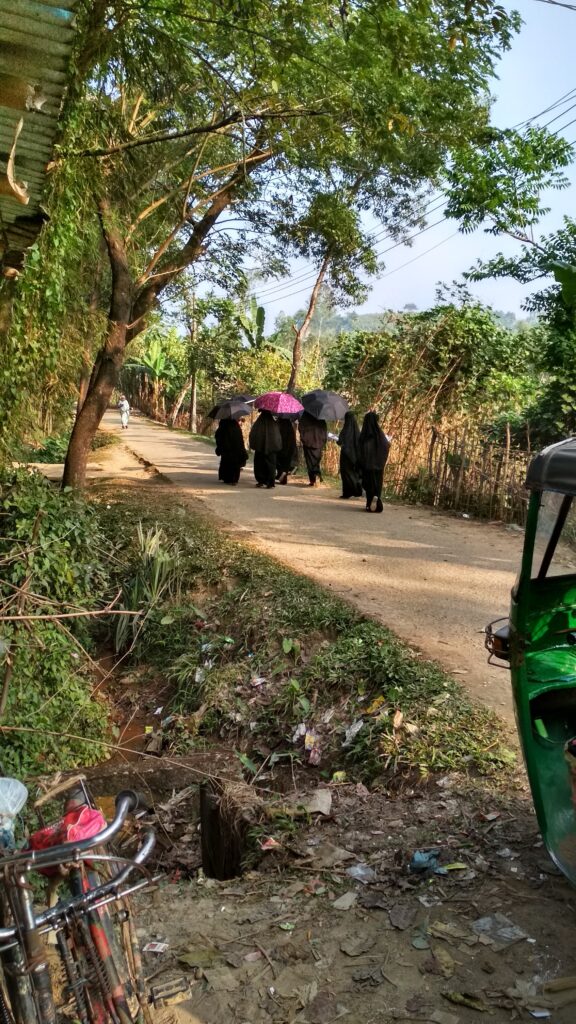
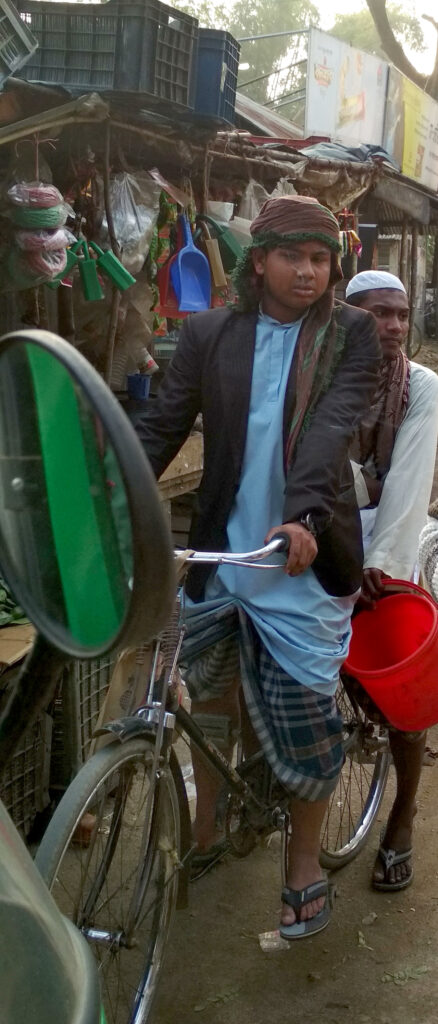
This was January and the sun was most pleasant. Yet the girls were carrying umbrellas, as if to make invisible whatever could still be seen. Perhaps I was reacting from my position as a woman, with my own ideas of freedom and bondage. Perhaps the girls did not feel the pressure that I was feeling. Photo: Moushumi, 2018
We started to walk in the direction of Doudik village, someone suggested we look for a man named Moyna babu, who could know something. But the man was not to be found; we found his house but learned that he had gone to Sylhet that day.
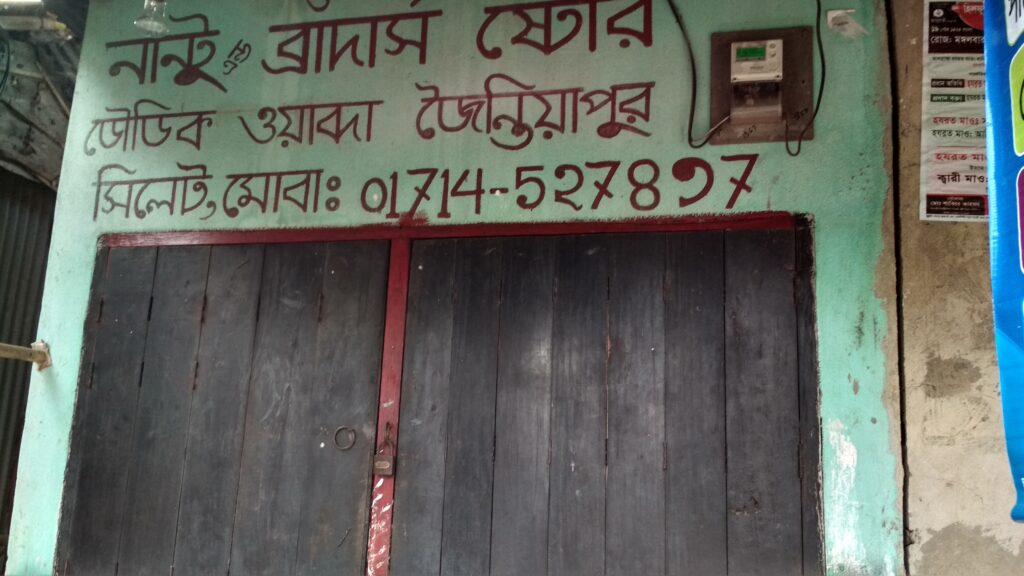
Nantu and Brothers Store, Doudik, Jaintiapur, was closed at the time of our visit. There was a mobile number to contact the shop-owner. Photo: Moushumi, 2018
We found however a house full of women. The courtyard was decorated with alpona, or auspicious patterns drawn on the floor with rice paste. This was a Hindu household. The ever-friendly Ambarishda got talking with the women. They were busy, some taking utensils to clean at the hand pump, some tending to their children. Ambarishda convinced them that there should be some singing and dancing; I added my request to his, as did Azad Miah. There was one elderly man, he said his name was Parindra Namo. The women were Sitarani Namo, Anjali Rani Biswas, Kajoli Rani Biswas, Dipali and others. So, this was a Namasudra village. The women were not at all shy and seemed quite eager to sing. They said, if you come back on Sunday, we will sing more properly that day. Then they left whatever work they were doing and brought their songbook and sang and danced around the alpona. They sang about Lord Krishna’s childhood, and their voices reminded me of the Janmashtami songs that Sudheer Palsane and I had recorded during a field trip in Cachar on the other side of the border, all the way back in 2005.
I love this recording for all the layers of sound it holds. The laughter of children, the sound of the clatter of utensils, of drawing water from the hand pump and then probably a loudspeaker in a village mosque, behind the foregrounded women’s chorus singing of Lord Sri Krishna, with one strong voice providing lead. Recorded on my Zoom H4N recorder.
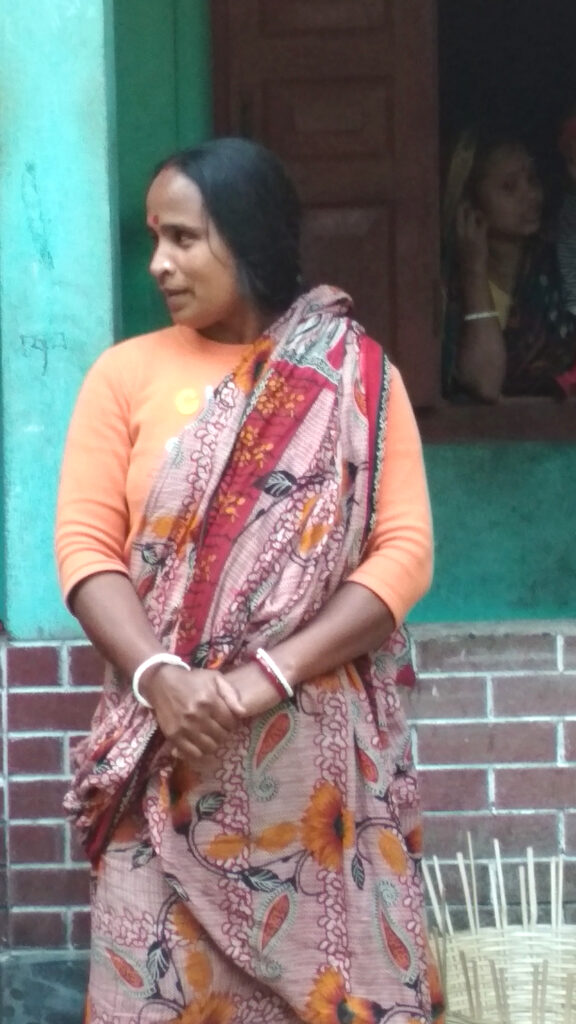
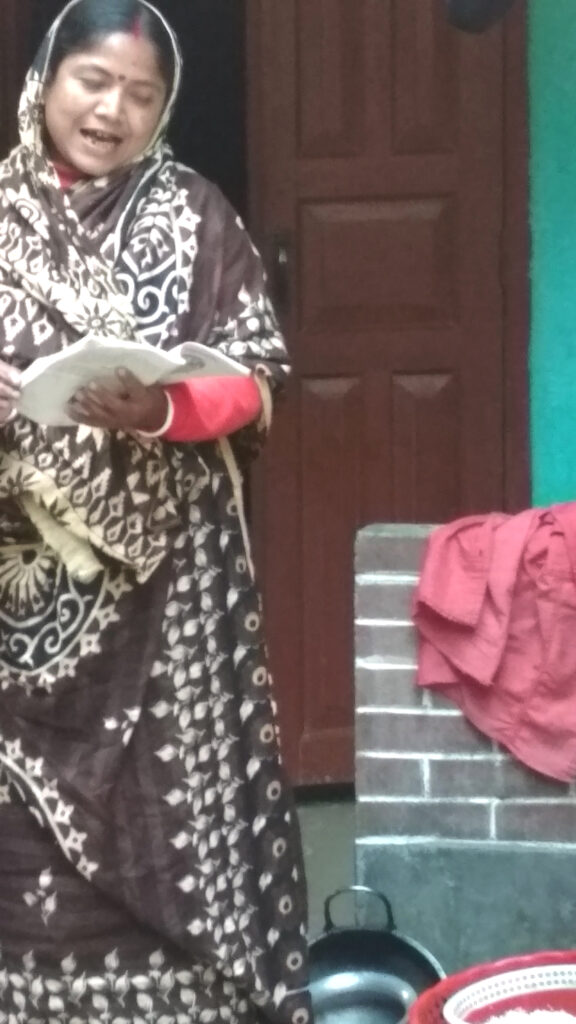
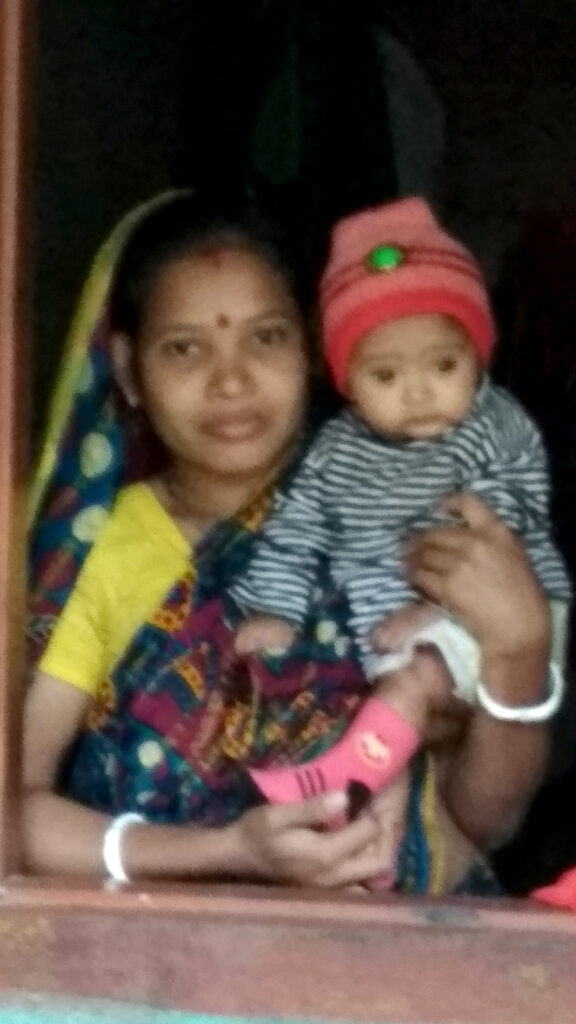
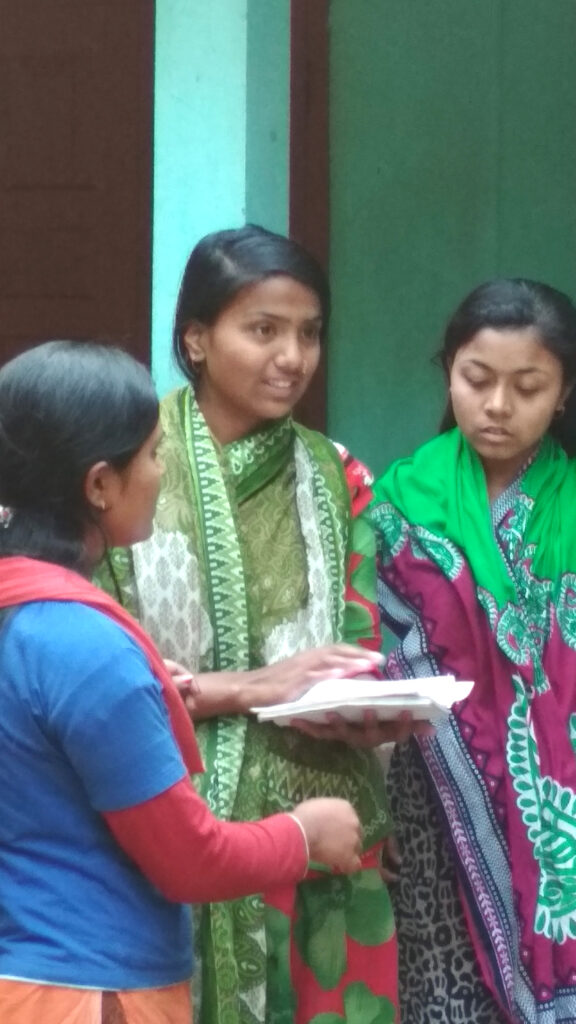
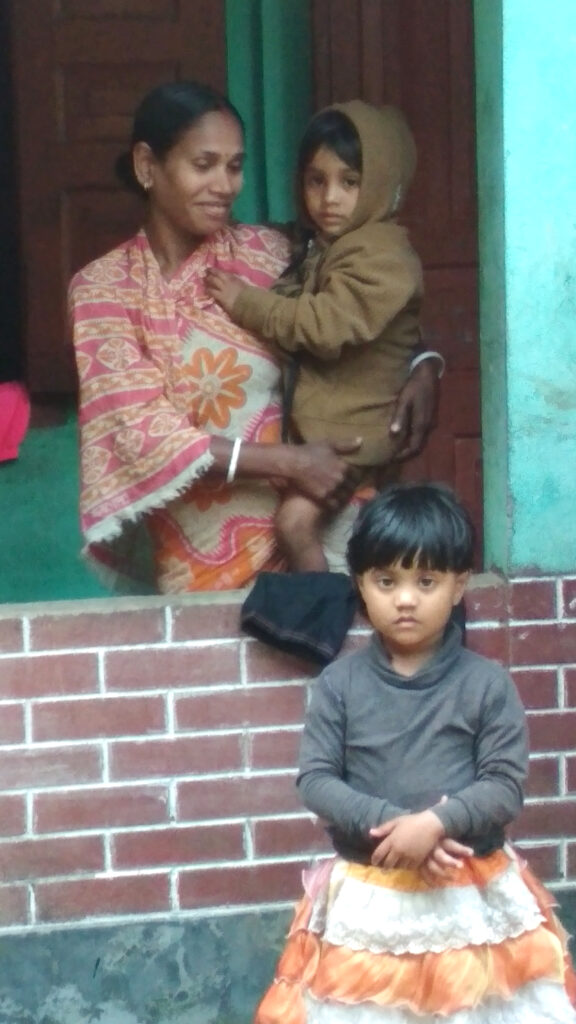
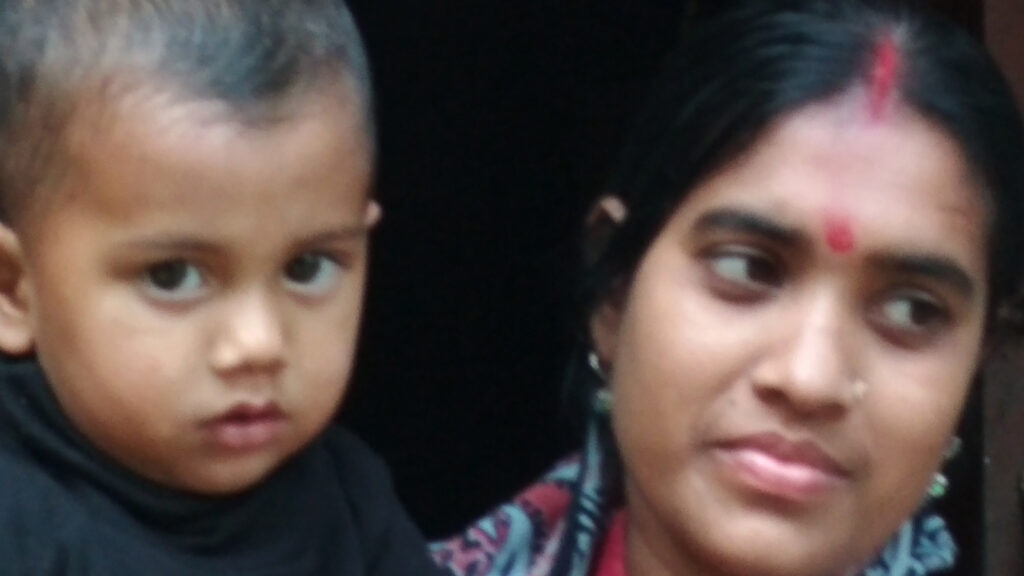
The women of Doudik who sang for us. Photo: Moushumi
‘Let us sing a doodhjaaler gaan.’ ‘Let us sing a song about boiling the milk,’ the women said. ‘Sing as you please, sing what gives you ananda or happiness’ Ambarishda said. ‘No, we will sing to please you, for your ananda.’
These are songs of the cowherd community. Radha was a maiden of the community, a gopika. Krishna, a leader. But actually a god. Radha the supreme devotee. The song they sing is about when Krishna was a little boy, waiting for his creamy milk. And his mother milks the cow and brings the milk to a boil and then she put it in a earthen pot.
Rani dugdho de go jaal / Shorononi khaibare naase Nondolal / Dhenu duaiya Rani/ Choliya aila ghare/ Boshaila dudher hnari/Chularo upore/ Aguro chandano kashthe/ Aguni jwalaiya/ Ego, utholiya pore dugdho / Asharero chula/ Dugdho jaalo diya rani/ Namaiya rakhila /Shitolo koriya dugdho/ Bhandete rakhila
Boil the milk, Rani [Jashoda, mother of Krishna, queen of the cowherds]. Nandalal or little Krishna dances with joy at the thought of eating the creamy delight. Rani milks the cow and brings in the milk, puts it on the stove and lights the fire with sandalwood and agar [the sweet smell of the fire therefore fills the air]. The milk boils and rises in a wave, she takes it down from the fire and pours into a clay pot.
Video recorded by Moushumi (asking Ambarishda to hold the Zoom H4N) on her Redmi phone-camera. 18 January 2018.
After this trip Asadbhai would call me from time to time, as long as I was in Bangladesh and my local sim was still active, and say: ‘Apa, we will find Fayazullah’s village, I am sure that we will. I have talked with so and so. Don’t you worry. We are getting close.’
